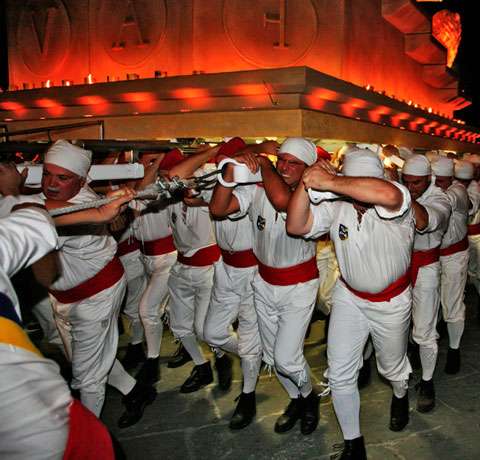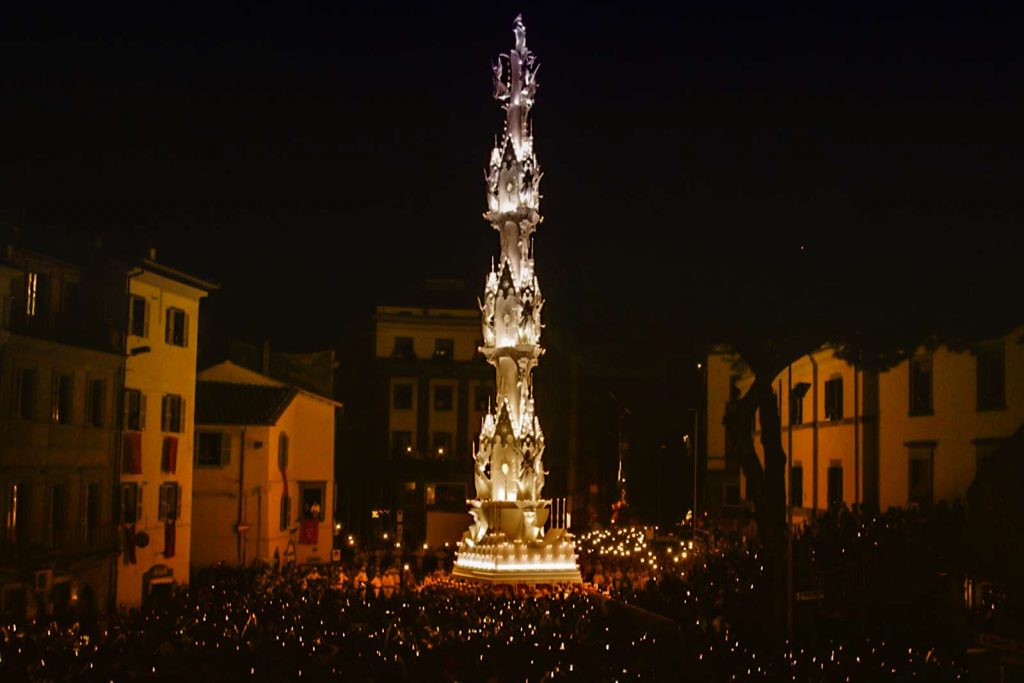The Transport of Macchina di Santa Rosa is an UNESCO Intangible Cultural Heritage of Humanity that is held in Viterbo every year on the night of September, 3rd. The Macchina di Santa Rosa is a huge tower lit by torches and electric lights, made of light metals. It is about 30 meters high and is carried on the shoulders of a hundred facchini (porters) for a distance of about one kilometer, which starts from the church of San Sisto and arrives at the church of Santa Rosa, passing through the streets of the city.

It is a very ancient tradition that dates back to the 13th century. Over the centuries it was stopped only for two unfortunate events: war and Coronavirus.
2020 and 2021 will go down in history as the years of Covid-19, and without the transport of Macchina di Santa Rosa. The interruption of this tradition was received by Viterbesi (citizens of Viterbo) as a kind of calamity.

Saint Rosa is the patron saint of Viterbo and there is a strong bond between her and all the community of this pretty medieval town. Faith, devotion, prayers, and votive offerings are the main manifestations of gratitude of people to this saint whose embalmed body is kept in a glass urn in the church of Santa Rosa.
Rosa is perceived as a saint, but also as a member of the family, or a dear friend who you can rely on. So, the faithful pass on their faith to God through her, in a mix of divine and human relationships that make them feel closer to heaven.
A Tradition of Over Eight Hundred Years

The tradition of Trasporto della Macchina di Santa Rosa takes its origin from a specific event. On 4 September 1258, the body of Rosa, who died in 1251, was found intact, and was transferred on the shoulders of some cardinals, in the presence of Pope Alexander IV, to the monastery of San Damiano. It is now the church where the saint is still kept and venerated.
Ever since, a hundred men called Facchini di Santa Rosa (porters), on the night of September 3rd, carry on their shoulders, and through the narrow streets of the medieval city, the Macchina di Santa Rosa, a huge tower 30 meters high (98ft) and 51 quintals of weight (about 11,000 pounds). The transport is accompanied by a parade of a band playing the traditional Saint Rosa’s music.


Giampaolo Zarletti, Porter © Brotherhood of Holy Rose’s Porters 
Massimo Mecarini, President of the Brotherhood of Holy Rose’s Porters
This tradition that commemorates Saint Rosa is followed by thousands of people who come from all over Italy, and that gather along the streets and squares of the city, or look out from their balconies and rooftops. Thousands of spectators can enjoy the event on television.
Museum of Sodalizio dei Facchini di Santa Rosa
Over the years the design of the Macchina has changed a lot, according to a new artistic vision and a more modern style. But some of the symbolic elements that recall the saint and the city of Viterbo, must be respected in the structure of the tower, in order to maintain the tradition intact.
At the museum of the Sodalizio dei Facchini di Santa Rosa (Sodality of porters of Saint Rosa) it is possible to admire the sketches of the Macchine that have been built over the centuries. Each Macchina has a name.
Massimo Mecarini, former facchino and President of Sodalizio dei Facchini di Santa Rosa, says that there is a specific tower that marks a watershed moment (spartiacque in Italian) the history of the Macchina. It is the so-called Macchina del Volo degli Angeli (Flight of the Angels). In fact, for the first time, the statue of Saint Rosa was placed on the top of the tower, replacing the cross.

In addition, that tower was so heavy that in 1967 they had to stop the transport halfway. For this reason, the following year (1968) they decided to introduce a test to measure the capacity of an aspirant facchino of carrying on his shoulder a weight of 150 kilos for 90 meters. This test is still in practice today and is a fundamental requirement for being a facchino (porter).
At the museum of Sodalizio dei Facchini di Santa Rosa it is also possible to admire other relics and objects linked to this tradition. But above all you can find a gem, that is a ciuffo (a particular headdress that porters wear to protect the neck) that the astronaut Roberto Vittori brought into space in the Space Shuttle Endeavor mission. There is also the certificate of authenticity issued by NASA.
A curiosity: nowhere it is written that a facchino must be a man, women are also allowed. In fact, the 1978 Statue says that the tower can be carried by any person who passes the weight test and has a healthy, sturdy physique. However, no woman has so far passed that test, but some women are in the Sodality as part of the medical staff.
Intangible Cultural Heritage of Humanity
UNESCO proclaimed the transport of Macchina di Santa Rosa as an Intangible Cultural Heritage of Humanity.
It all started in 2006 with an association called La Rete delle Grandi Macchine a Spalla (The Network of the Great Shoulder Machines) which at the beginning included four Italian Catholic religious festivals: the Macchina di Santa Rosa of Viterbo; the Festa dei Gigli of Nola; the Varia of Palmi; the Faradda in the Candareri of Sassari; and the Corsa dei Ceri of Gubbio.
Subsequently, Gubbio broke away from the network to compete alone for the title of UNESCO.
On 4 December 2013, UNESCO awarded the prestigious award to the Network of Great Shoulder Machines as Intangible Cultural Heritage of Humanity. Gubbio, no longer part of the network, was excluded from the title.
Massimo Mecarini says: “Now we want to help our friends from Gubbio to again join the network to obtain the title of UNESCO, even if it will not be easy”.
And he adds: “We must not take this title for granted, but work every year to keep this tradition alive, passing it on to future generations”. The title in fact, over time is subject to revision to verify that the tradition is still authentic.
The Private Side of the Tradition
Giampaolo Zarletti says that the Trasporto della Macchina di Santa Rosa has two faces: one folkloric that belongs to the public, and another one very private, which belongs only to the porters and their families.
Giampaolo is a facchino by vocation. As a child he saw this huge illuminated tower pass through the narrow streets of his city and, with his heart full of emotion, he dreamed of becoming a porter one day. Now that he has fulfilled his dream, he hopes that his son will also receive this vocation.
He says that there is a private side of the tradition linked to the dressing of the facchino and to all the blessings he receives in the so-called tour of the seven churches. In fact, after the ritual of dressing with the members of the family, handing to the porter the white uniform and the red belt, the facchini procession begins. Two hundred facchini compactly parade through the city, visiting the major churches and bringing honors to war memorials.
For the facchino, the feast of Saint Rosa starts early in the morning and ends late at night. For the public, the feast begins in the evening when the city lights turn off and the illuminated macchina starts its parade.
The first facchino shouts: “Facchini di Santa Rosa, sollevate e fermi! “(Porters of Saint Rosa, lift and hold steady!).
The macchina lifts up ready to start, and a roar of amazement rises from the crowd. Chills run down the backs of all the audience, and the city burns on emotions. Uno, due… uno, due! (one, two… one, two!) facchini march, and the tower moves through the city streets.
Evviva Santa Rosa! Hurray!
Saint Rosa’s Resilience
Sister Francesca belongs to the order of the Alcantarine Franciscan nuns and lives in the monastery of Saint Rosa. She describes Rosa as a poor, small and fragile maiden, who was born with a severe malformation, which is the lack of breastbone. Rosa died at the age of 18 (1251) after defending the church against the power of Frederick II.
The nun thinks that Saint Rosa wants to leave a message to today’s women, not to be overwhelmed by the violence, aggression, and cruelty of which they are often victims, and put their trust in God.

Saint Rosa teaches all women, through her sacrifice, to be resilient and never give up.
Note: Although Covid-19 has prevented the transport of the Macchina di Santa Rosa this year too, the municipality of Viterbo has decided to exhibit the tower in the Piazza del Comune for a few days, for the joy and venerations of citizens and tourists.

You may also enjoy reading:
Bomarzo and Its Mysteries
Enjoy the Real Italy in San Martino al Cimino
Experiences That Will Fill Your Heart in Roccalvecce





